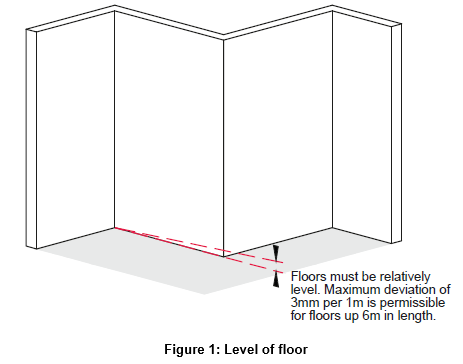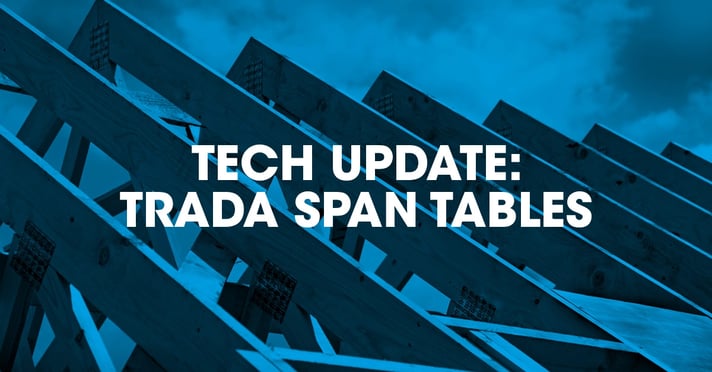TRADA span tables
The ‘Eurocode 5 span tables for solid timber members in floors, ceilings and roofs for dwellings. 4th edition’; contains section sizes and spans for solid timber members in floors, ceilings and roofs (excluding trussed rafter roofs) for dwellings. The calculations apply to buildings up to three storeys in height above ground level. At the time of writing, this is the ‘current’ published edition.
History of span tables
Span tables for joists, rafters, purlins etc. were contained within Approved Document A which supported the Building Regulations for England and Wales. They helped designers and builders quickly look up the right sized softwood members for domestic projects.
From 2004, Approved Document A no longer contained these tables, instead reference was made to using the TRADA Span Tables as one solution to meeting Requirement A1: Loading of the Building Regulations.
The 1st edition of the ‘Tables’ was published in 2004 by TRADA Technology Ltd and reprinted with amendments in 2005. The 2nd edition was published and reprinted in 2008 by TRADA Technology Ltd. The 3rd edition published in 2009 and was reprinted with corrections. The current version is the 4th edition and was published in 2014. The TRADA document continues to be referenced in Approved Document A.
The Technical Manual
The ‘Upper Floors’ section of the Technical Manual advises; the designer should refer to one of three sources. One of these is the TRADA span tables, i.e.
“Span tables for solid timber members in floors, ceilings and roofs (excluding trussed rafter roofs) for dwellings. Published by TRADA. Note: Reference should be made to the version of the TRADA document current at the time of construction of the floor / timber or roof.”
In the event of a claim, it will need to be determined which edition of the TRADA document is relevant at the time the floor was constructed.
Approved Document A; England and Approved Document A; Wales, both state:
“Guidance on the sizing of certain members in floors and roofs is given in ‘Span tables for solid timber members in floors, ceilings and roofs (excluding trussed rafter roofs) for dwellings’, published by TRADA, available from Chiltern House, Stocking Lane, Hughenden Valley, High Wycombe, Bucks HP14 4ND.”
The Approved documents do not specify a version or edition of the TRADA span tables. This allows for subsequent revisions of the TRADA document to occur until the next amendment of the Approved document is issued. By not dating the TRADA document, it allows for the most current published version to be applicable to building work carried out.
Please note; the TRADA span tables are not referred to in the equivalent Scottish Technical Handbook ‘Structure’.
What are the changes in the 2014 edition?
The main changes of the Eurocode 5, 2014 edition is that the document is now in 8 sections (see below):
- Contents.
- Timber specification.
- Design considerations.
- Tables of sizes of timber floor members.
- Tables of sizes of celling members.
- Tables of sizes of pitched roof members.
- Tables of sizes of flat roof joists and Part 8 references.
Another major difference is the imposed load. On the 2004 span tables, there is only one value given for imposed load, which makes no allowance for concentrated or line loads. However, the most current edition requires two values for imposed loads. The tables require that you specify the point load and the uniform distributed load, making the maximum allowed span more accurate.
This 4th edition also includes revisions for:
- Enhanced shear strength: Those spans where shear is the governing criterion have been improved.
- Enhanced bearing strength: The bearing lengths required have reduced which in turn increased the clear spans in some instances.
- Trimmer tables: Span tables for doubled-up trimmer and trimming joists are included and are consistent with the permanent loading situations of the floor joists tables. Reactions and fastener tables are included.
- Changes to some section sizes: An industry survey has prompted changes to the range of member sizes offered in the tables.
- Commentary that distributed loads produced by a full bath can exceed the 1.5kN/m2 imposed load for which normal floor joists are designed. Therefore all joists beneath a bath should be doubled.
Summary
Surveyors using the IHS system will note that when reading the history summary to the 2004 Edition of the TRADA span tables, it states “Not current but cited in the Building Regulations”. This is misleading in that the ‘current’ Approved Document A does not refer to the 2004 edition. The latest span table should be now used, due to changes in code and safety factors. Also the transition period of being able to use previous no longer current codes has now ended.
The current wording in our Technical Manual provides clarification to the Designer, Developer or Surveyors that the version of the TRADA span tables, current at time of construction is the version that will apply for projects using our Warranty.
When checking a floor joist is the correct size for a given span; a check that ‘Designers’ have observed our tolerances requirements for maximum out of level found within the ‘Tolerances’ section of our Technical Manual.
Floors must be relatively level. Maximum deviation of 3mm per 1m is permissible for floors up 6m in length. Floors over 6m horizontal length are permitted to have a maximum deviation of 20mm across their length.
Shrinkage of timber floors and staircases is a natural occurrence when drying out, which could result in the squeaking of materials as they move against each other. This again is a natural occurrence, and cannot be eliminated entirely.

Deflection
The deflection limit must be 0.003 X the span with a maximum deflection of 14mm where strutting is provided and 12mm where strutting is not provided. This is based on the total and imposed loads for combined bending and shear.
The Engineer must ensure that the design of the floor construction does not deflect greater than the above tolerances, unless the relevant BS or EN design code requires the deflection to be smaller.

